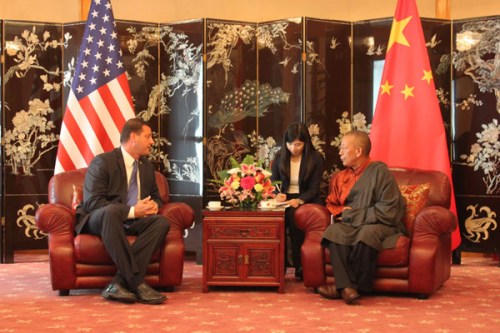
US Congressman David Valadao (left) meets with ShingtsaTenzinchodrak (right), Tibetan deputy to China's National People's Congress, on April 8 at the Chinese Consulate General in San Francisco. (Photo: Lia Zhu/China Daily)
Shingtsa Tenzinchodrak, a living buddha of Tibetan Buddhism, liked to tell stories of himself during his stay in the United States.
Leading a delegation of the National People's Congress (NPC) of China, Tenzinchodrak toured San Francisco and Houston from April 7 through 11 to promote Tibet Autonomous Region, where he is serving as vice-chairman of the Standing Committee of the People's Congress.
Now aged 64, Tenzinchodrak remembers himself being recognized at the age of five as a reincarnated living buddha, thus starting to learn reading and writing from religious scholars, and then became a teacher at a village school when he was nine years old. As shown in his profile, he taught at three schools from 1959 to 1964.
The matter of fact, he told reporters and some scholars at Stanford University in California, was that very few people a half century ago in Tibet had a chance to go to school and far fewer people had basic skills needed to teach kids.
The difference, as he tried to explain to people in the United States, including several members of the House of Representatives (lower house), was that Tibet now has a system providing the population with education through primary and secondary schools and institutions of higher learning.
The changes in Tenzinchodrak's lifetime have been the result of steady rise of social-economic status of Tibetans within China, with tremendous resources pouring in from China's central government and ongoing assistance from other provinces and regions across the country.
It is the second time for Tenzinchodrak, a member of the NPC, to head the top legislature's delegation on overseas missions to promote Tibet. The first tour, in 2009, took him to U.S. cities of Washington D.C. and New York and then to Canada.
The next year, 2010, the village hosting the Shingtsa Temple, from which Tenzinchodrak got his first name because of the reincarnation in 1955, started to get electricity supply from the nation's power grid, a development he had deemed remotely possible in 50 years due to difficulties imposed by the village's high altitude above sea level and the sparse locations of villagers' households.
He rejected the notion that his role as a top regional legislator could have helped his village neighbors to connect with power grid.
Notifying that he and other key members of his delegation are "people on the ground at the snow covered (Tibetan) plateau," meaning they know more about what is going on there, Tenzinchodrak prides himself for the facts that the average life span of Tibetans is 68.2 years now compared with 35.5 years in 1959, and that one third of the land in the autonomous region has been in the national registry for conservation.
Asked about his plan for retirement, Tenzinchodrak said he would spend most or at least more of his time at the Shingtsa Temple.
















































